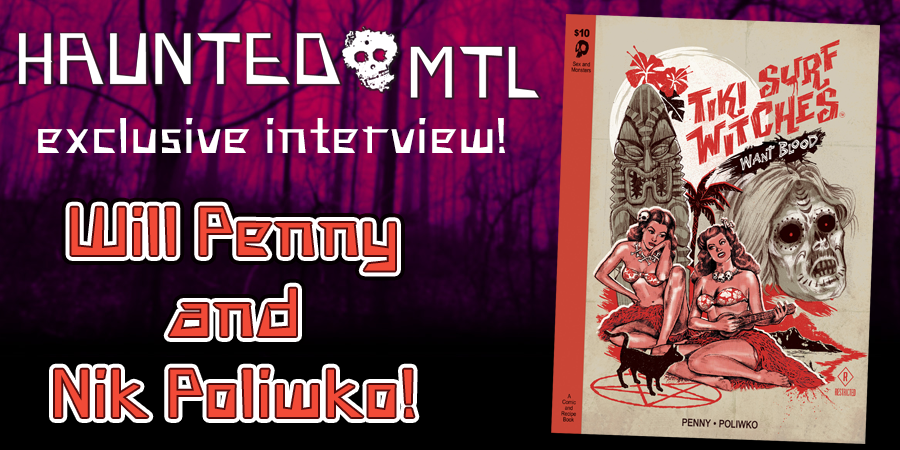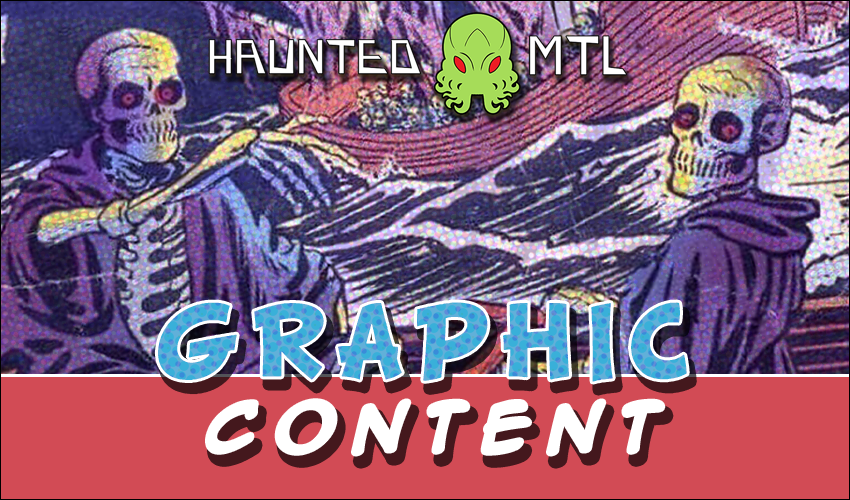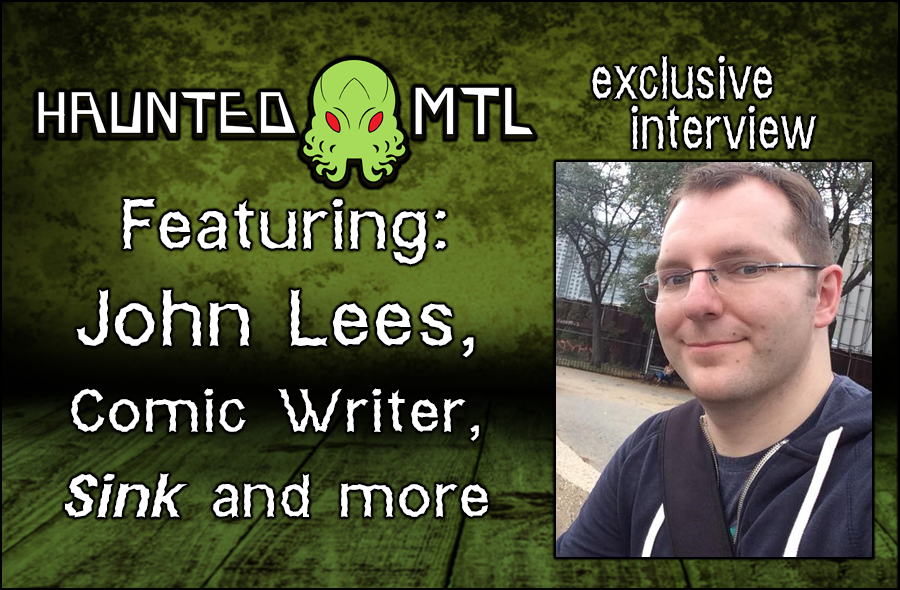
Interview: Will Penny and Nik Poliwko of “Tiki Surf Witches Want Blood”
More Videos
Published
6 years agoon
As horror fans we are often drawn to the little things. Covers and titles are hugely influential to many of us, particularly as we seek to expand our horror experiences. For many folks of my generation we remember the joy of walking down the horror aisle of the local Blockbuster Video or spinning the racks of comics at the local book store. So, when I came across a booth at WonderCon 2019 for a group called Sex and Monsters, and read the title of a comic called Tiki Surf Witches Want Blood, I was intrigued.
I am pleased to reveal that that title is exactly what you get with this comic and more. You not only get Tiki Surf Witches, but blood craving, and even better, a whole array of tasty recipes for great island drinks! I reached out to the team behind the comic, Will Penny (the writer) and Nik Poliwko (the artist), with some questions, and as a bonus we even have a preview of the book, exclusively for Haunted MTL. Oh, and beware, the comic is NSFW for blood, breasts, and witchcraft.
Interview
Will, where did the idea come from to mash up a horror story and cocktail recipes?
Will: I’ve always been into the horror genre, but back in 2016 I was really getting into tiki culture too. So I thought it’d be fun to create a tiki-themed horror comic. While I was brainstorming story ideas (and probably after too many rum cocktails) I struck on the idea of creating a comic book that also doubled as a cocktail-recipe book. I figured the combination would create a bit of extra escapism for readers.
Will, the story has a very old school feel to it, what horror works and/or writers influenced you as a writer on this project, Will?
Will: The story probably gets its “old school feel” from the fact that I decided to write something that wasn’t too cynical.
Tiki culture has its roots in the ‘30s, when Donn Beach created the first tiki bar in Hollywood, but things really took off for “tiki” in the ‘50s, after American GIs returned home from war, having served time in the South Pacific. So when I decided to make a tiki-themed comic, I wanted the artwork to serve as a visual reference to that specific time period. So the “look” of the book is definitely inspired by all those classic EC horror comics from the ‘50s. Fortunately, I was lucky enough to have Nik Poliwko illustrate the book, who really nailed the visual vibe I was shooting for.
In regards to the actual story, I was inspired by a lot of late-night b-movies – particularly the work of Roger Corman and Del Tenney. But I also wanted to make sure the story would stand on its own merits and not just be something that MST3K could lampoon. So I tried to make sure each of the characters – particularly the female characters – had their own specific traits and motivations that would move the plot forward.
My real goal (and challenge) was to use the visual language of black-and-white b-movies and pre-code horror comics to tell an engaging (and even romantic) story that could still appeal to a modern audience.
Nik, your illustrations have a very classic, E.C. Comics style to them, were those comics a primary influence on you?
Nik: Love the EC stuff, although the Warren mags (Creepy, Eerie and Vampirella) were more prominent for me. My influences tend to be more the artist than the comic, and a few EC artists do show up. Russ Manning would have to be my first major influence, followed by Alex Raymond, Hal Foster, Will Eisner, Al Williamson, Frank Frazetta’s comic work, and of course Wally Wood. On the horror side of things, Bernie Wrightson would be a major influence, on the EC side of things it would be Jack Davis’ horror work, Graham Ingels and Bernie Krigstein. Some others would be Jack Kirby, Jim Steranko and Barry Windsor-Smith.
Will, Are there any other plans for tiki-influenced horror projects?
Will: Yes! On June 1st we’ll be launching our first Kickstarter campaign to fund the creation of a “magic” Zombie cocktail glass. Donn Beach created the original Zombie cocktail back in 1934, and traditionally served it in a tall chimney-style glass. The drink was so popular that the glassware it was served in became known as a “Zombie glass.”
So I’m working with Nik Poliwko again to develop an authentic-style Zombie glass that will incorporate Nik’s fantastic artwork and — for the fist time ever — will cause the dead to rise whenever a cocktail is poured into it! It’s going to be a real fun (and functional) art piece for anyone who likes horror, tiki culture, zombies, or just wants to drink cocktails while learning how to raise the dead!
I don’t want to give away too many more secrets or surprises, but if people want to stay up-to-date on this project, they can follow us on Instagram @sexandmonsters or sign up for our newsletter here.
Nik, your work is recognizable from The Creeps Magazine, do you have any particular stories you contributed to for the magazine you’d want people to check out?
Nik: Heh… people should check out ALL my stories in The Creeps! A few faves of mine include issue 11’s “If You Knew Sushi,” written by Don Glut, “Mary Shelley in Frankenstein’s Castle,” in issue 12, written by Nicola Cuti, and another Cuti masterpiece, “Graveyard Dance,” in issue # 13, which reveals the origin of “The Old Creep,” the host of The Creeps. And another Don Glut thriller, “Interview with a Werewolf” in issue 15.
Of the cocktails in the book, what is your personal favorite?
Will: My personal favorite tiki cocktail is the Zombie! Not only because it’s a strong and well-balanced drink, but it also has a rich and fascinating history (that people can read more about in Sippin’ Safari by Jeff Berry).
I’m also partial to the Surfer’s Blood – the climax cocktail of the book. It’s inspired by a type of Mai Tai served at Old Tony’s — one of my favorite bars in Redondo Beach, CA. It’s boozy and tart, and includes a “secret ingredient” called kook juice (a mix of Tang and sparkling lemonade)!
Nik: I’d have to say I love me a good “Zombie,” with “R.I.P. Tide” coming a close 2nd. Really hard to pick favorites as all the recipes are so good!
Will, Can you talk to us a bit about the origins of Sex and Monsters? What does the future hold for the studio?
Will: Sex and Monsters was just a silly name that I came up with for my personal webcomic about 10 years ago. But after awhile, the name grew into its own publishing brand, and now I work with a variety of artists and writers to make a bunch of fun stuff.
After we launch our “Zombie glass” Kickstarter, we’ll be publishing a comic adaptation of Edgar Allen Poe and H. P. Lovecraft material, we’ll also be featuring more work by the extremely talented and hilarious Alison Zai, and finally we have a soundtrack to “Tiki Surf Witches Want Blood” coming down the pike — a 7 inch vinyl record by our pals Dom Kreep and the Grim County Coroners.
Nik, were your illustrations for Tiki Surf Witches Want Blood traditionally done or digital? Do you have a preference for most of your work?
Nik: “Tiki Surf Witches…” was all digital, as is all my work these days. I’ve worked traditional for many years and when I picked up a Wacom Cintiq tablet back in 2010, it’s been digital ever since. Personally I love it, and at this point, prefer it over drawing on paper.
Will, what is it that you think allows horror and sexuality to blend together so effectively?
Will: I’m by no means an expert in this field, but I imagine the combination of sex and horror in fiction has been around since people first started telling stories. We certainly see this combination presented in the subtext of Victorian era Gothic fiction (like Dracula), and we see it become more overt in the early 20th century with pulp detective novels. In fact, the very first horror comic book published in 1947 – Avon’s Eerie Comics #1 – combined elements of sex and horror on its cover through the juxtaposition of a menacing ghoul and a scantily-clad female.
But I wasn’t really thinking about this history when I chose the name “Sex and Monsters” for my publishing company. I just thought it was a catchy name, and would let people know right off the bat that we’re not afraid to produce stuff that’s a bit offbeat or more quirky than mainstream publishers. And even though the name may imply that our work features gratuitous nudity and violence, I try to invert those expectations, and present the elements of sexuality and horror in a way that has purpose, or is in service to the overall story we’re trying to tell.
…Of course, it’s always fun to be a little gratuitous once in awhile too!
Preview
Enjoy this preview of the bloody fun inside Tiki Surf Witches Want Blood, including the recipe for the classic island cocktail, The Zombie!
Oh, and beware the boobs!




Thanks for reading, and stay tuned for more interviews here at Haunted MTL.
David Davis is a writer, cartoonist, and educator in Southern California with an M.A. in literature and writing studies.

You may like
Book Reviews
The Hotel: We’ll All Be There Soon.
Published
2 weeks agoon
March 17, 2025By
C M ReidDaisy Johnson’s, The Hotel is a collection of stories that tell the tale of a hotel built on cursed land. Originally written and recorded as a series for BBC Radio 4 in 2020, (you can find the recordings here https://www.bbc.co.uk/programmes/m000mrcg/episodes/player )
The fourteen-story collection was released in hardcover in 2021. Johnson’s prose is haunting, weaving together the stories of generations of families who have been tempted, forced, or serendipitously dumped at The Hotel. Most leave the message, “I’ll be there soon,” and many disappear from room 63.
- ‘The British literary heir to Stephen King’ Johanna Thomas-Corr, Sunday TimesA triumph of contemporary horror from the Booker Prize-shortlisted author, this collection of short stories will haunt you long after you turn the final pageA place of myths, rumours and secrets, The Hotel looms over the dark Fens, tall and grey in its Gothic splendour
- Built on cursed land, a history of violent death suffuses its very foundations –yet it has a magnetism that is impossible to ignore
- On entering The Hotel, different people react in different ways
Last update on 2025-03-17 / Affiliate links / Images from Amazon Product Advertising API
The Plot.
The Hotel tells the stories of the people who are drawn to The Hotel, or, more accurately, the ground the hotel is built on. The first story explains what we know about the hotel, its tendencies, moods, and … hobbies. We are then introduced to Mary Southgraves, ‘The Witch’, who comes to live with her husband on the land on which The Hotel will be built. The villagers in the pond drown her for predicting a sickness that takes the village children, (no this is not a spoiler she tells you she dies on the first page of her chapter.)
The proceeding chapters build upon this story. We meet the workers who are brought in to fill the pond to begin construction. A child of a guest in 1968 who meets another girl who may or may not actually be there. A maid who takes part in séances and Ouija board sessions. The stories progress through time into the present.
Highlights.
The haunting prose of The Hotel does the majority of the heavy lifting for this collection, which makes sense since it began as a podcast series. Johnson’s prose leans towards poetry, albeit more Poe than Keats.
The repetition of specific characters and family names throughout the different stories was intriguing, giving the stories links. These links trigger a sense of recognition for the reader. There is also a sense of anticipation, knowing what has happened to these families already, we wonder how much more they can withstand. The Hotel is like a curse following these families, but I think Johnson is commenting on lineage and the consequences of past actions. The sins of the father and all that.
- Fifteen highly original and darkly unsettling supernatural stories, performed by some of Britain’s finest actresses ‘This is what we know about The Hotel
- It is bigger on the inside than on the outside
- Do not go into Room 63
Last update on 2025-03-17 / Affiliate links / Images from Amazon Product Advertising API
Drawbacks.
These stories can get confusing at times and I think this is due to the briefness of the stories. It’s hard to keep track of a character that you have spent four pages with and remember them three stories later. I found myself having to stop and turn back to check if that person was who I thought they were. This pausing to turn back interrupts the reading experience. It pulls you out of the story and destroys the atmosphere that Johnson has worked to create.
The Final Take.
The Hotel was an interesting read. Johnson is a talented writer who has published a collection of linked stories that will keep the reader turning pages if only to find out the final fate of these families. That being said, it is obvious that the stories were initially written for a podcast. I’m not sure if it’s the way they are put together or… I don’t know, there’s just something ‘podcasty’ about them. As such I would recommend listening to the audio episodes (see the link above) over reading the book.
 (3 / 5)
(3 / 5)
On Halloween in 2016 Josh Malerman, author of Bird Box, released A House At The Bottom Of A Lake (gosh this is a hefty title!). Last week, I picked this slim book up off my library’s Adult Horror shelves, not knowing what to expect. What I got was a novella that should have been shelved in the teen lit section. Perhaps it is the rather weird underwater sex scene that precludes it from those shelves.
- From the New York Times bestselling author of Bird Box and Malorie comes a haunting tale of love and mystery, as the date of a lifetime becomes a maddening exploration of the depths of the heart
- “Malerman expertly conjures a fairy tale nostalgia of first love, and we follow along, all too willingly, ignoring the warning signs even as the fear takes hold
- ”—Lit Reactor The story begins: young lovers, anxious to connect, agree to a first date, thinking outside of the box
Last update on 2025-03-10 / Affiliate links / Images from Amazon Product Advertising API
The Plot.
When James asks Amelia out on a date during summer break, canoeing was the last thing that she expected. Borrowing his uncles canoe, James hopes he can show Amelia an exciting time, because he really likes this girl! The date starts well and the conversation, if stilted at times, is banter-ey and cool.
They head out on the first lake, but James has an idea that they might have a better time on the lake that joins to this one. It is quieter, no speed boats to show him up, they’ll be able to eat their picnic lunch in peace and quiet. When they arrive, though, they notice a tunnel, that may lead to a third lake. Eager to show Amelia that he is an exciting kind of guy, James heads through the tunnel.
Lo and behold, it is another lake! Albeit, a bit murky and deserted, but that’s alright. That is until they notice that beneath the bow of the boat is a tiled roof. Beneath that tiled roof is a whole house. What ensues is a summer of falling in love and exploring a sunken house that may not be as empty as they thought.
Highlights.
Malerman writing the internal monologue of an angsty seventeen-year-old on a first date is one of the most authentic things I’ve read for a long time. Even down to James worrying about revealing that his dad owns the hardware shop he works in. Scared that Amelia will think that is all he is going to do with his life.
The ending (which of course I cannot discuss here) was well done, although a little contrived and predictable. It felt as if it had been almost tacked on the end as an afterthought. Perhaps Malerman finished the story without the final chapter, but was encouraged to add that last bit to give readers some closure
- “A book that demands to be read in a single sitting, and through the cracks between one’s fingers
- There has never been a horror story quite like this
- Josh Malerman truly delivers
Last update on 2025-03-10 / Affiliate links / Images from Amazon Product Advertising API
Drawbacks.
Malerman is a good writer, we have seen this in the many novels he has released since Bird Box. A House At The Bottom Of A Lake did not meet the usual standard. There are many reasons I say this. The first is a lack of creativity in descriptive passages in this book. They all felt pretty drab and began to become repetitive by the end of the story. I don’t know how many, times Malerman compared the way that James and Amelia were moving under the water in their scuba suits as ‘Astronaut-like’ or ‘Astronaut-esque’ or ‘ Like he was walking without gravity’, but really can you find another comparison please because this one is all used up!
As I mentioned in the intro, this did feel like a YA novel. Not only because both of the main characters are seventeen, but the prose is a too simple to be engaging. A House A The Bottom Of A Lake might be marketed differently in Australia (where this humble reviewer lives), perhaps making it to the YA shelves in the US or UK, but this is definitely not adult horror.
The Final Take.
Josh Malerman is a favorite of mine. I tend to pick up his books, blurb unread, because I will generally enjoy what he is putting out there. The exception to this rule is A House At The Bottom Of A Lake (if I never have to type that title again I will be pleased!). It just didn’t hit the way his other novels have and I was disappointed.
 (2 / 5)
(2 / 5)
Imagine this. You’re home alone, waiting for your partner to return, when you hear a knock on your door. You answer it to see a family of five, bundled up against the cold. The father, a kindly older gentleman, explains that he used to live in this house as a boy. And he would love to show it to his family.
Do not let them in.
The story
Released in June 2024, We Used To Live Here is author Marcus Kliewer’s debut novel. It tells the story of Eve, who just purchased a beautiful house with her partner, Charlie. Their plan is to flip the house and sell it.
One night, while waiting for Charlie to come home, Eve is surprised by a knock at the door. It’s a man named Thomas Faust and his family.
Thomas explains that he grew up in the house and hasn’t been in the area in years. Would Eve let them in so that he can show the home to his children?
Against her better judgment, Eve lets them in. She regrets this almost at once when Thomas’s daughter vanishes somewhere into the house.
What worked
I always appreciate a book that allows you to play along with the mystery. And this book does that better than just about any other I’ve seen.
Pay close attention to the chapters, to the words that aren’t there. To everything about this novel.
This is mostly down to Kliewer. This is ultimately his work of art. But the production value is also fantastic. I don’t want to ruin the multiple mysteries, so I’ll just say this. There are clues in this book that require some specific artistic choices in the page layouts in this book. And I loved that.
If you’d like to experience another horror book review, check out this one.
We Used To Live Here is also the kind of story that makes you question everything right along with the main character, Eve. Eve is a great main character. But she might be an unreliable narrator. She might be experiencing every single horror described, exactly as it’s described. Or, she might be having a psychotic breakdown. Through most of the book, we can’t be sure. And that is so much fun.
Finally, the weather plays a large part in this story. There are several stories in which the weather or the land itself could be considered a character. Even an antagonist. This is certainly one. The winter storm is the thing that traps the family in the house with Eve. It also makes escaping the home difficult. Reading this book during the winter was especially impactful. Most of us know what it feels like to be shut in by a storm. I’ve personally lived through some of those storms that are just referred to by their year, as though they were impactful enough to claim the whole 365 days for themself. And that was with people I liked. Imagine what it would feel like with strangers. It’s a staggering thought and one that we explore in depth in this book.
- Get Out meets Parasite in this eerily haunting debut and Reddit hit—soon to be a Netflix original movie starring Blake Lively—about two homeowners whose lives are turned upside down when the house’s previous residents unexpectedly visit
- As a young, queer couple who flip houses, Charlie and Eve can’t believe the killer deal they’ve just gotten on an old house in a picturesque neighborhood
- As they’re working in the house one day, there’s a knock on the door
Last update on 2025-03-08 / Affiliate links / Images from Amazon Product Advertising API
In the end, We Used To Live Here is a fantastic book. It’s the sort of story that sneaks into your brain and puts down roots. And if this is just the first book we’re getting from Kliewer, I can’t wait to see what else he comes up with.
 (5 / 5)
(5 / 5)








